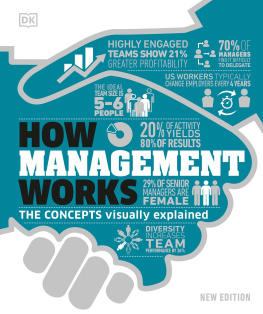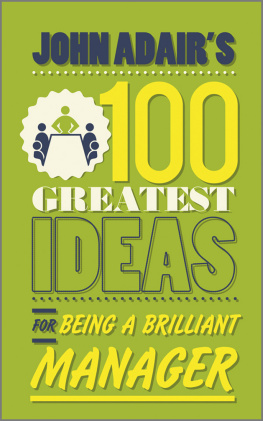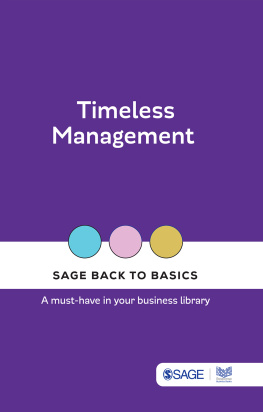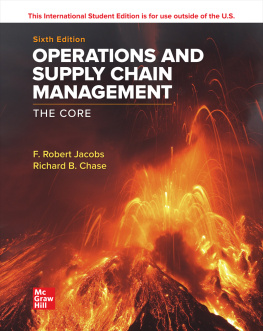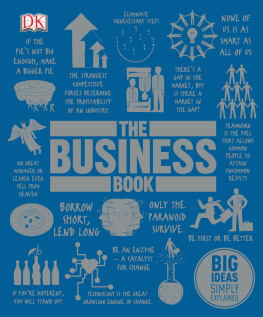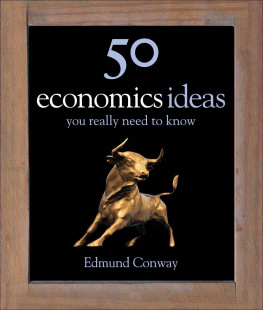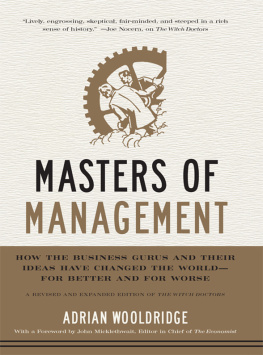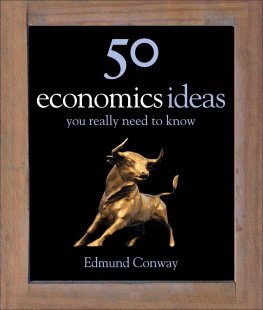Contents
management ideas
you really need to know

Edward Russell-Walling

Introduction
Companies are much like people, if you dont look too closely. You get a few kind thoughtful ones, a few grasping ugly ones, and many shades in between. Like the rest of us, they want to get on, earn more and influence others. And they think about how to do all thata lot. A handful of them have enough confidence and self-knowledge to work it out for themselves. Others feel happier going to a professional for advice. The rest, and there are plenty of them, wait to see what everyone else is doing and then copy their ideas.
Original or borrowed, those ideas are the subject of this book. They may be about overall strategyhow the company plans to get to where it wants to be. Some are about styles of management. Others look at organizationhow the company structures itself and arranges its systems. There are different management ideas on how to compete, motivate people or improve quality, on leadership and even on ways of thinking.
Management ideas are a product, like any other. They often begin as practice inside innovative companies, but they are usually hammered into theoriesmanufactured as ideasinside the business schools. From there they go to idea retailers, the management and business consultants, who distribute them among the corporate population at large. Companies put the ideas to work and give feedback on any faults, the academics tweak the design and, if its a sound idea, the cycle continues.
Like any other product, ideas have a value, which can be high, especially when they are shiny and new. But they also have a shelf life. An eye-catching idea becomes the hottest management must-have for a while and then sinks from view, as managers realize it didnt really do what it said on the tin. Some are better than others and become part of the mainstream, adapted for new times. Other hot properties are overhyped and oversold, then fall from grace, though some of their essence survives as part of accepted thought. This continual cycle of new lamps for old is perpetuated partly by the academics and consultants, who need new product flow if they are to have a business at all, and partly by demand from managements, with their robust appetite for anything that promises to make their businesses better.
Management has never quite decided whether its an art or a science. Science promises certainty, which is an elusive quality in modern business, and managers would dearly love to have a little more of it. Its that lack of product guarantee, in a world that insists on changing, that will keep new management ideas bubbling up, continually adding to the evolutionary diversity that I hope this book reveals.
Glossary
Amortized cost The value of assets wastes away, so their cost is charged against profitsamortizedover a number of years. The more years, the smaller the annual charge.
Barriers to entry/exit Factors that prevent new competitors from entering a market, or existing ones from leaving it. Usually related to cost or know-howhence cost of entry.
Bricks and clicks Joint use of the web and physical outlets as complementary distribution channels. Sometimes called clicks and mortar.
Capital Financial or physical assets used to produce an income. Includes money invested in a business (share capital) or borrowed by it (loan capital). Investors expect a return on [the] capital [they have] invested (ROCI).
Clicks and mortarsee Bricks and clicks
Commoditized Describes products where no single brand has any differentiating features and consumers buy on price alone.
Conglomerate A collection of companies in unrelated businesses, usually owned by a holding company. No longer favored by investors.
Consolidation In an industry, a reduction in the number of competitors as the bigger ones acquire or eliminate the smaller ones.
Convergence Buzzword of the 1990s, describing the growing interdependence of telecommunications, computers and the media. Strategic convergence is the growing similarity of individual corporate strategies.
Core business The business at the heart of an organizations success. Likewise, core products and core skills. These should never be outsourced.
Cost of entrysee Barriers to entry/exit
Disclosure Providing relevant information on trading activities, financial performance, assets and liabilities to shareholders and other interested parties.
Efficiency vs. effectiveness Efficiency is saving time, money or effort (doing things rightPeter Drucker). Effectiveness is doing a quality job that achieves its goals (doing the right things).
Entrepreneur Someone who undertakes (from the French entreprendreto undertake) to supply the market for a profit. Implies a spirit of initiative and risk-taking.
Ethical investment An investment style that avoids shares in unethical companies, such as those in arms or tobacco, or heavy polluters. For some, corporate governance is also an ethical issue.
5S Japanese system of order and cleanliness in the workplaceseiri (tidiness), seiton (orderliness), seiso (cleanliness), seiketsu (standards) and shitsuke (sustaining discipline).
Flatteningsee Hierarchical organization
Flotationsee IPO
Function A distinct department of the business, usually with its own budget, such as sales, production, marketing, human resources and finance.
Goodharts Law In essence, when a measure becomes a target it stops being a good measure, because it changes the focus of peoples activity.
Hierarchical organization An organization with many layers of management, often pyramid-like, with each reporting upward until they reach the top. Flattening is removing some of these layers.
Inventory Stocks of supplies, work in progress or finished products within the company at any one time.
IPO Initial public offering. Inviting the public to invest in a companys shares for the first time. Otherwise known as flotation, listing or even getting quoted.
Listingsee IPO
Logistics Technically, managing the flow of materials and information along the supply chain, but often used, more specifically, to mean transport and storage.
Margin Profit as a percentage of sales. High margin is good, low margin less so.
Mass customization Adapting a mass-produced product for individual consumption.
Metrics Jargon for measurements.
Multinationals Companies with operations established in more than one country. Some now prefer to think of themselves as global companies.
NGO Non-governmental organization, usually with altruistic purpose. Often involved in stakeholder and corporate social responsibility issues.
Niche A smaller portion of a larger market. Niche marketing is much more targeted than mass marketing.


